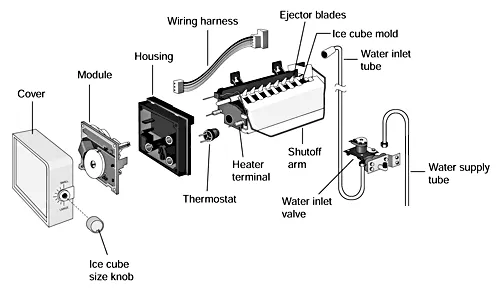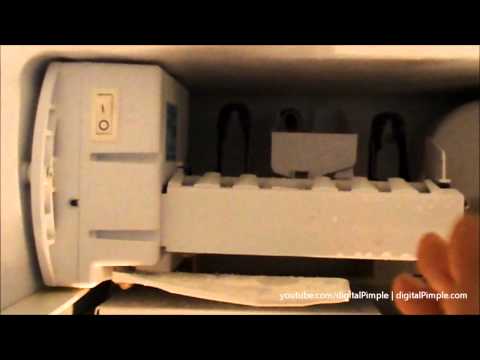Asking yourself, “Why is my GE refrigerator not making ice” over and over again but can’t find the answer? Well, we are here to your rescue.
A GE refrigerator may not be making enough ice or no ice at all if the water lines and filter are dirty and clogged, along with wrong temperature settings, defective water in-let valve, damaged fan, low water pressure, etc.
Troubleshooting these problems will be very challenging on your own and may even require intervention by a professional electrician. However, with our solution guide you will be able to handle the minor issues like a pro even without prior experience and knowledge.
Go grab that toolkit box and let’s get started!
Table Of Contents

How Does Your GE Refrigerator Ice Maker Work?
If you have some background knowledge on the different components of a GE refrigerator ice maker and how they operate together like a team to get those ice cubes going, you’ll be able to diagnose the specific problems easily and then take measures accordingly.
That’s why we thought it would be wise to introduce you to the world of ice makers before answering your long-awaited question – “Why My GE Cafe Refrigerator is Not Making Ice?” Nevertheless, no matter whether you have a ‘Cafe’ refrigerator or a model from the ‘Profile’ series, it’s going to include these same typical components:

- Ice mold or tray
- Water inlet valve
- Water supply line
- Ice maker control module
- Thermostat
- Motor
- Heater
- Dispenser chute
- Ice bin
- Auger (if applicable)
- Solenoid (for ice dispenser, if applicable)
- Wiring and connectors
First, water is supplied to the ice maker from the main water line. This water flows into a small reservoir, where it is measured and monitored by a sensor.
When the ice level drops below a certain point, the sensor signals the ice maker to initiate the freezing cycle. A motor-driven pump transports the water from the reservoir to a special ice mold or tray.
Within this mold, small heating elements might be employed to slightly warm the bottom of the mold, ensuring easy release of the ice cubes. Once the mold is filled with water, a refrigeration unit, commonly located in the freezer compartment, cools the water rapidly.
As a result, the water freezes from the outside in, pushing out any air or impurities, and forming clear ice cubes.
Once fully frozen, the heating elements are activated again to gently warm the mold’s bottom, allowing the cubes to detach and fall into the ice bin.
The process then repeats as needed to maintain the ice supply, providing a continuous source of ice for your convenience.
Why is My GE Refrigerator Not Making Ice? Common Reasons
Phew! Now it’s finally time to answer your question, “Why My GE Refrigerator is Not Making Ice?” Here’s a list of all the possible reasons:
When pressing the ice dispenser flap and door switch on indoor ice-dispensing refrigerator models with the door open, make sure the indicator light remains illuminated continuously.
If the freezer temperature is too high, the condenser coils and condenser fan will not function properly. Additionally, look to see if the evaporator coils have accumulated any ice buildup or frost. In that case, a manual defrost will be required.
At least a pressure of 20 psi is needed for the valve to operate effectively, otherwise the ice maker won’t be able to produce ice. To confirm whether the water pressure is sufficient or not, check the water inlet valve’s power using a multimeter.
You can defrost the frozen fill tube with a hair dryer or replace the fill tube with a new one if it looks to be damaged.
You should contact a professional electrician to come and inspect the board for any severe damage or a short circuited component. Replace it if needed. If it looks physically alright, you should then use a multimeter to test if sufficient voltage is being sent to the ice maker.
To know how much power your ice maker consumes, consult with the User Manual and review the refrigerator’s wiring diagram.
Therefore, GE manufacturers advise to replace the water filter about every six months to maintain smooth water flow and ensure water quality if you’re too busy to clean and maintain regularly.
To figure out if the door switch is defective or not, use a multimeter to test it for continuity. If the door switch does not have continuity when activated, replace it right away.
The ice makerwon’t turn on if the ice level control board is broken. If the fridge has an in-door ice dispenser, open the door and make sure the indicator light remains on while you press the door switch and ice dispenser paddle.
If not, there’s a good chance the ice level control board is broken.
How To Fix GE Refrigerator Not Making Ice Problems?

We have discussed all the possible problems now let’s talk about what you can do to fix them!
Based on our long-term experience with GE refrigerators, the most common problem that prevents ice makers from making ice cubes is when certain components are blocked due to frost build-up, especially the water pipes, fan blades, coils etc.
Therefore, your first concern should be to know how to defrost them.
You may have to wait up to 24 hours after resetting before your appliance starts making ice again. Then, ice makers will produce 2 trays of ice every 3 hours.
Once in forced defrost mode the heaters in the freezer will run a heating cycle for 20-30 minutes, and upwards to one hour. Some GE models will beep every second for the entire defrost cycle. It’s best to leave the room and maintain sanity.
If you see water melting, try to remove chunks of ice from the ice maker before running another defrost cycle. This process may take 20-30 minutes each cycle.
Enter diagnostic mode again as you did with the Forced Defrost, but this time select RD. This cycle normally takes 20-30 minutes, and may take longer depending on ice buildup.
If resetting and defrosting the ice maker doesn’t perform the magic, then you should attempt these solutions one after another:
Frequently Asked Questions
Having issues with your GE refrigerator not producing ice? We have compiled answers to the most common questions about this problem. This is your resource for resolving any GE Ice Maker issues.
My GE Ice Maker Seems to be Leaking. What to Do?
Check for loose or damaged water lines around the ice maker. Tighten connections or replace damaged parts. If the issue persists, it might be best to consult a technician.
Why is My GE Profile Refrigerator Not Making Ice?
There could be several reasons, including a disconnected water supply, clogged/dirty water lines and valve, defective water filter, ice maker turned off, a malfunctioning ice maker assembly, etc. Follow our troubleshooting guidelines to identify and resolve the issues.
Why is There a Bad Taste or Odor in My Ice?
Odors or tastes in ice can come from dirty water filters and filthy water pipes. Thoroughly clean them up with soapy solution. You may also replace the water filter and flush the water system to eliminate any lingering flavors.
Can a Power Outage Affect Ice Production in My GE Refrigerator?
Yes, a power outage can disrupt the ice-making process. Once power is restored, the refrigerator may take some time to reach the optimal temperature and resume ice production.
Can Hard Water Affect Ice Production and Quality?
Yes, hard water can cause mineral deposits that affect your GE refrigerator ice maker’s efficiency and quality. Use a water softener or a dedicated filter.
Why is My GE Refrigerator Making Ice Slowly?
Slow ice production indicates low water pressure, high room temperatures, or overfilling the ice bin. Address these issues to improve ice production speed.
Final Thoughts
We hope we were able to clear the fog and answer your question “Why is My GE Refrigerator Not Making Ice?”
You don’t have to be a refrigerator geek to resolve the problems, simply following our DIY suggestions is enough. Not to mention, you can always ask for help from either any local repairman or GE customer helpdesk.
Remember, if you keep your refrigerator (not just the front and sides but the back unit too) clean and tidy and ensure proper maintenance, you won’t have to suffer these same problems with your refrigerator ice maker again in the future.
